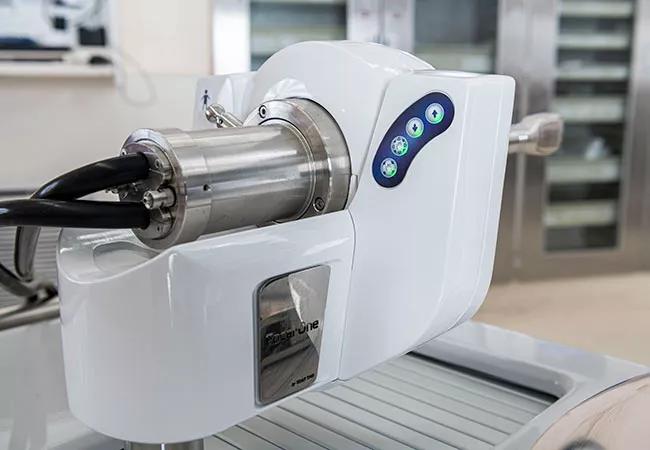Advertisement
What’s ahead in the Focal Therapy Program at Cleveland Clinic

By Robert Abouassaly, MD; and Christopher Weight, MD
Advertisement
Cleveland Clinic is a non-profit academic medical center. Advertising on our site helps support our mission. We do not endorse non-Cleveland Clinic products or services. Policy
High-intensity focused ultrasound (HIFU), a type of focal therapy for treating localized prostate cancer, is emerging as an alternative to more traditional treatments, such as surgery and radiation, for select patients. The modality relies on high-frequency sound waves directed at the tumor through an ultrasound probe inserted into the rectum. The high-intensity waves cause the diseased tissue to heat up and die.
Improved HIFU technology, coupled with appropriate patient selection, is enabling us to provide this modality as an outpatient procedure. Cleveland Clinic recently acquired a Focal One® machine, making it one of very few sites locally and nationally to offer this technology. It combines ablative and imaging techniques to target tumors in the prostate, enabling an attractive 1.5-hour, non-invasive procedure for clinically indicated patients. We describe a recent case using this device – the first in Ohio – in the below summary:
We recently treated a patient on active surveillance whose one-year interval biopsy showed an increase in aggressiveness from Gleason score (GS) 6 to GS 7. His MRI showed that he had only one tumor; it was 1 cm in diameter. His prostate was about 40 grams. All other random biopsies were negative. In addition to active surveillance, we discussed HIFU therapy, radical prostatectomy, or radiation therapy as treatment options. He ultimately chose HIFU therapy as a middle ground among these options.
The outpatient procedure took about 1.5 hours. He reported no side effects and returned to full activity four days postoperatively. We recommended that he return for a PSA in six months and an MRI with a biopsy in 12 months.
HIFU therapy is not intended to replace active surveillance — even for a patient with a low-risk tumor. It is only appropriate for about 10% to 15% of prostate cancer patients. This includes patients with a GS of 3+4 or 3+3 and a high Decipher, Prolaris or Oncotype Dx score, and those who have a tumor that is easily visible on MRI and in a favorable anatomic location.
For clinically indicated patients, this procedure means no incontinence and no bowel-related symptoms, both of which can occur with traditional treatments. Since we’re only treating part of the prostate, the data suggest that it offers better preservation and potency. However, some patients may experience temporary diminishment in erections, particularly if they don’t have a good baseline erectile function.
We are heartened by the outcomes we’ve observed with this new technology. It’s a testament to advancements in imaging, biopsying and discoveries in prostate cancer pathology. Going forward we will continue careful selection of patients and judicious use of the technology.
Follow-up after HIFU includes a PSA at six months; if it has declined appropriately, then another PSA, MRI and biopsy are performed at one year. A follow-up regimen over the long term is under development as experience with the technology grows.
Advertisement
We are also collecting data to determine the long-term safety and efficacy of this technology to better understand any potential long-term side effects and recurrence rates. However, based on what we have seen so far, the short-term side effects are certainly acceptable.
The Focal Therapy Program at Cleveland Clinic remains a priority for us. We recently recruited Dr. Rubén Olivares, one of the most experienced HIFU providers in the world, from Chile. We also plan to open a training center to train providers at Cleveland Clinic and around the world on the Focal One machine. Additionally, we will soon begin enrolling patients for a clinical trial to examine another form of focal therapy, laser ablation, designed to ablate tissue after the infusion of nanoparticles to localize and guide the laser fiber directly into the tumor.
We are eager to continue integrating these modalities into our practice, evaluating short- and long-term outcomes, and delivering the highest quality of care to our patients.
Advertisement
Advertisement

Polygenic risk score could help predict who will develop this aggressive breast cancer

New guidelines offer insight into emerging therapies, dental issues and more

Clinical trial to assess the value of nutritional, physical therapy and social supports prior to preoperative chemotherapy

Research demonstrates improved overall survival for patients receiving comprehensive treatment for breast cancer in addition to radiation or surgical intervention for brain cancer

Platinum-eligible phase 3 trial of enfortumab vedotin and pembrolizumab yields ‘unprecedented data’

Cleveland Clinic Cancer Institute brings multidisciplinary care, precision oncology and clinical research to the United Arab Emirates

Extent of baseline burden impacts progression-free and overall survival

Further study warranted to better understand the clinical implications of these findings